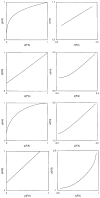Word frequency and receiver operating characteristic curves in recognition memory: evidence for a dual-process interpretation
- PMID: 12219793
- PMCID: PMC2435057
- DOI: 10.1037//0278-7393.28.5.830
Word frequency and receiver operating characteristic curves in recognition memory: evidence for a dual-process interpretation
Abstract
Dual-process models of the word-frequency mirror effect posit that low-frequency words are recollected more often than high-frequency words, producing the hit rate differences in the word-frequency effect, whereas high-frequency words are more familiar, producing the false-alarm-rate differences. In this pair of experiments, the authors demonstrate that the analysis of receiver operating characteristic (ROC) curves provides critical information in support of this interpretation. Specifically, when participants were required to discriminate between studied nouns and their plurality reversed complements, the ROC curve was accurately described by a threshold model that is consistent with recollection-based recognition. Further, the plurality discrimination ROC curves showed characteristics consistent with the interpretation that participants recollected low-frequency items more than high-frequency items.
Figures




References
-
- Atkinson RC, Juola JF. Search and decision processes in recognition memory. In: Krantz DH, Atkinson RC, Luce RD, Suppes P, editors. Contemporary developments in mathematical psychology: Vol. 1. Learning, memory, and thinking. New York: Freeman; 1974. pp. 243–293.
-
- Benjamin AS, Bjork RA, Hirshman E. Predicting the future and reconstructing the past: A Bayesian characterization of the utility of subjective fluency. Acta Psychologica. 1998;98:267–290. - PubMed
-
- Clark SE, Gronlund SD. Global matching models of memory: How the models match the data. Psychonomic Bulletin & Review. 1996;3:37– 60. - PubMed
-
- Cohen J. Statistical power analysis for the behavioral sciences. Hillsdale, NJ: Erlbaum; 1988.
-
- Dodson CS, Prinzmetal W, Shimamura AP. Using Excel to estimate parameters from observed data: An example from source memory data. Behavior Research Methods, Instruments, and Computers. 1998;30:517–526.

